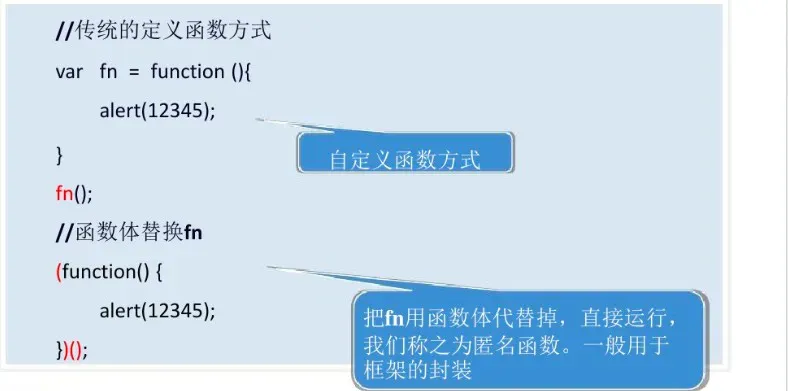JavaScript中的函数分为两种:系统函数和自定义函数,这里主要讲解自定义函数。
自定义函数
1、语法:

注意:
- 传入的参数是可选的。
例如:
<!DOCTYPE html>
<html lang="en">
<head>
<meta charset="UTF-8">
<meta name="viewport" content="width=device-width, initial-scale=1.0">
<meta http-equiv="X-UA-Compatible" content="ie=edge">
<title>自定义函数</title>
<script>
// 语法1自定义无参函数
function custom(){
document.write("自定义无参函数,使用第一种语法定义"+"<br />")
};
// 语法2
var customer=function(){
document.write("自定义无参函数,使用第二种语法定义"+"<br />")
};
// 定义有参函数
function customWithPara(i){
document.write("自定义有参函数,使用第一种语法定义,i的值是:"+i+"<br />")
};
// 语法2
var customerWithPara=function(i){
document.write("自定义有参函数,使用第二种语法定义,i的值是:"+i+"<br />")
};
</script>
</head>
<body>
</body>
</html>2、函数的调用
函数可以通过函数名加上括号中的参数进行调用。
例如:
<!DOCTYPE html>
<html lang="en">
<head>
<meta charset="UTF-8">
<meta name="viewport" content="width=device-width, initial-scale=1.0">
<meta http-equiv="X-UA-Compatible" content="ie=edge">
<title>函数调用</title>
</head>
<body>
<script>
// 定义无参函数
function custom(){
document.write("这是无参的函数"+"<br />");
};
// 定义无参的函数变量
var customer=function(){
document.write("这是无参的函数变量"+"<br />");
};
// 定义有参函数
function customWithPara(para){
document.write("这是有参函数,参数值是:"+para+"<br />");
}
// 定义有参的函数变量
var customerWithPara =function(para){
document.write("这是有参的函数变量,参数值是:"+para+"<br />");
}
// 函数调用
// 1、调用无参函数
custom();
// 2、调用有参函数
customWithPara(45);
// 无参函数变量的调用
customer();
// 有参函数变量的调用
customerWithPara(23);
</script>
</body>
</html>结果:

注意:
- 调用函数时需要注意函数调用的顺序。如果是自定义函数,那么也可以在函数定义之前调用函数,因为这时会自动把函数的定义放到最前面。如果是通过变量的形式定义函数,那么必须先定义函数才能调用。
看下面的例子:
<!DOCTYPE html>
<html lang="en">
<head>
<meta charset="UTF-8">
<meta name="viewport" content="width=device-width, initial-scale=1.0">
<meta http-equiv="X-UA-Compatible" content="ie=edge">
<title>函数调用</title>
</head>
<body>
<script>
// 函数调用
// 1、调用无参函数
custom();
// 2、调用有参函数
customWithPara(45);
// 无参函数变量的调用
customer();
// 有参函数变量的调用
customerWithPara(23);
// 定义无参函数
function custom(){
document.write("这是无参的函数"+"<br />");
};
// 定义无参的函数变量
var customer=function(){
document.write("这是无参的函数变量"+"<br />");
};
// 定义有参函数
function customWithPara(para){
document.write("这是有参函数,参数值是:"+para+"<br />");
}
// 定义有参的函数变量
var customerWithPara =function(para){
document.write("这是有参的函数变量,参数值是:"+para+"<br />");
}
</script>
</body>
</html>结果:

3、匿名函数
匿名函数:顾名思义,即没有函数名称的函数。其语法如下图所示:

例如:
<!DOCTYPE html>
<html lang="en">
<head>
<meta charset="UTF-8">
<meta name="viewport" content="width=device-width, initial-scale=1.0">
<meta http-equiv="X-UA-Compatible" content="ie=edge">
<title>匿名函数</title>
</head>
<body>
<script>
// 传统定义函数的方式
function fn(){
document.write("这是传统函数的定义"+"<br />");
};
// 调用
fn();
// 匿名函数的定义和调用
(function(){
document.write("这是匿名函数"+"<br />");
})();
</script>
</body>
</html>结果:

4、匿名函数的应用
匿名函数可以作为函数的参数进行调用,看下面的例子:
<!DOCTYPE html>
<html lang="en">
<head>
<meta charset="UTF-8">
<meta name="viewport" content="width=device-width, initial-scale=1.0">
<meta http-equiv="X-UA-Compatible" content="ie=edge">
<title>匿名函数的应用</title>
<script>
// 匿名函数应用
function fun(para){
document.write("参数的值是:"+para+"<br />");
};
// 用匿名函数作为函数的参数
fun(function(){
return 5;
}());
// 也可以使用下面的方式
function fu(para){
document.write("参数的值是:"+para()+"<br />");
};
fu(function(){
return "56";
});
</script>
</head>
<body>
</body>
</html>结果:

到此这篇关于JavaScript自定义函数用法的文章就介绍到这了。希望对大家的学习有所帮助,也希望大家多多支持aitechtogether.com。
